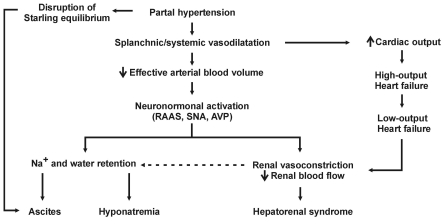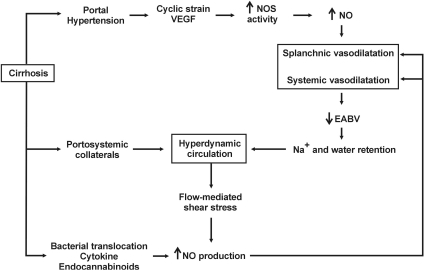Electrolyte Blood Press.
2009 Dec;7(2):42-50. 10.5049/EBP.2009.7.2.42.
Renal Dysfunction in Patients with Chronic Liver Disease
- Affiliations
-
- 1Division of Nephrology, Department of Internal Medicine, Chung-Ang University College of Medicine, Seoul, Korea. jwleemd@gmail.com
- KMID: 2052318
- DOI: http://doi.org/10.5049/EBP.2009.7.2.42
Abstract
- Renal dysfunction in patients with chronic liver disease encompasses a clinical spectrum of hyponatremia, ascites, and hepatorenal syndrome. Clinical observation has suggested that patients with cirrhosis have hyperdynamic circulation, and recent studies strongly suggest that peripheral arterial vasodilatation and subsequent development of hyperdynamic circulation are responsible for disturbances in renal function. Arterial vasodilatation predominantly occurs in the splanchnic vascular bed, and seems to precede an increase in blood flow in the splanchnic circulation. Nitric oxide plays a central role in progressive vasodilatation, as evidenced by in vivo and in vitro studies. Renal dysfunction negatively affects the prognosis of patients with cirrhosis, as hyponatremia, ascites, and azotemia are associated with increased rate of complications and mortality. Recent advances in understanding the pathophysiology of renal dysfunction have enabled clinicians to develop new diagnostic criteria and therapeutic recommendations. Hepatorenal syndrome is regarded as a potentially reversible disorder, as systemic vasoconstrictors with concomitant albumin administration are emerging as a promising management option, especially in terms of providing bridging therapy for patients awaiting liver transplantation.
Keyword
MeSH Terms
Figure
Reference
-
1. Angeli P, Wong F, Watson H, Gines P. Hyponatremia in cirrhosis: Results of a patient population survey. Hepatology. 2006; 44:1535–1542. PMID: 17133458.
Article2. Arroyo V, Gines P, Planas R, Panes J, Rodes J. Management of patients with cirrhosis and ascites. Semin Liver Dis. 1986; 6:353–369. PMID: 3544228.
Article3. Gonwa TA, McBride MA, Anderson K, Mai ML, Wadei H, Ahsan N. Continued influence of preoperative renal function on outcome of orthotopic liver transplant (OLTX) in the US: where will MELD lead us? Am J Transplant. 2006; 6:2651–2659. PMID: 16939515.
Article4. Salerno F, Gerbes A, Gines P, Wong F, Arroyo V. Diagnosis, prevention and treatment of hepatorenal syndrome in cirrhosis. Gut. 2007; 56:1310–1318. PMID: 17389705.
Article5. Wiest R. Splanchnic and systemic vasodilation: the experimental models. J Clin Gastroenterol. 2007; 41(Suppl 3):S272–S287. PMID: 17975477.6. Kowalski HJ, Abelmann WH. The cardiac output at rest in Laennec's cirrhosis. J Clin Invest. 1953; 32:1025–1033. PMID: 13096569.7. Murray JF, Dawson AM, Sherlock S. Circulatory changes in chronic liver disease. Am J Med. 1958; 24:358–367. PMID: 13520736.
Article8. Rivolta R, Maggi A, Cazzaniga M, et al. Reduction of renal cortical blood flow assessed by Doppler in cirrhotic patients with refractory ascites. Hepatology. 1998; 28:1235–1240. PMID: 9794906.
Article9. Sacerdoti D, Bolognesi M, Merkel C, Angeli P, Gatta A. Renal vasoconstriction in cirrhosis evaluated by duplex Doppler ultrasonography. Hepatology. 1993; 17:219–224. PMID: 8428719.
Article10. Sikuler E, Groszmann RJ. Interaction of flow and resistance in maintenance of portal hypertension in a rat model. Am J Physiol. 1986; 250:G205–G212. PMID: 3953799.
Article11. Ruiz-del-Arbol L, Monescillo A, Arocena C, et al. Circulatory function and hepatorenal syndrome in cirrhosis. Hepatology. 2005; 42:439–447. PMID: 15977202.
Article12. Arroyo V, Colmenero J. Ascites and hepatorenal syndrome in cirrhosis: pathophysiological basis of therapy and current management. J Hepatol. 2003; 38(Suppl 1):S69–S89. PMID: 12591187.
Article13. Atucha NM, Shah V, Garcia-Cardena G, Sessa WE, Groszmann RJ. Role of endothelium in the abnormal response of mesenteric vessels in rats with portal hypertension and liver cirrhosis. Gastroenterology. 1996; 111:1627–1632. PMID: 8942743.
Article14. Niederberger M, Gines P, Martin PY, et al. Comparison of vascular nitric oxide production and systemic hemodynamics in cirrhosis versus prehepatic portal hypertension in rats. Hepatology. 1996; 24:947–951. PMID: 8855203.
Article15. Claria J, Jimenez W, Ros J, et al. Pathogenesis of arterial hypotension in cirrhotic rats with ascites: role of endogenous nitric oxide. Hepatology. 1992; 15:343–349. PMID: 1735539.
Article16. Pizcueta MP, Pique JM, Bosch J, Whittle BJ, Moncada S. Effects of inhibiting nitric oxide biosynthesis on the systemic and splanchnic circulation of rats with portal hypertension. Br J Pharmacol. 1992; 105:184–190. PMID: 1596680.
Article17. Niederberger M, Martin PY, Gines P, et al. Normalization of nitric oxide production corrects arterial vasodilation and hyperdynamic circulation in cirrhotic rats. Gastroenterology. 1995; 109:1624–1630. PMID: 7557147.
Article18. Claria J, Jimenez W, Ros J, et al. Increased nitric oxide-dependent vasorelaxation in aortic rings of cirrhotic rats with ascites. Hepatology. 1994; 20:1615–1621. PMID: 7527007.
Article19. Gadano AC, Sogni P, Yang S, et al. Endothelial calcium-calmodulin dependent nitric oxide synthase in the in vitro vascular hyporeactivity of portal hypertensive rats. J Hepatol. 1997; 26:678–686. PMID: 9075677.
Article20. Colombato LA, Albillos A, Groszmann RJ. Temporal relationship of peripheral vasodilatation, plasma volume expansion and the hyperdynamic circulatory state in portal-hypertensive rats. Hepatology. 1992; 15:323–328. PMID: 1735537.
Article21. Wiest R, Shah V, Sessa WC, Groszmann RJ. NO overproduction by eNOS precedes hyperdynamic splanchnic circulation in portal hypertensive rats. Am J Physiol. 1999; 276:G1043–G1051. PMID: 10198349.22. Abraldes JG, Iwakiri Y, Loureiro-Silva M, Haq O, Sessa WC, Groszmann RJ. Mild increases in portal pressure upregulate vascular endothelial growth factor and endothelial nitric oxide synthase in the intestinal microcirculatory bed, leading to a hyperdynamic state. Am J Physiol Gastrointest Liver Physiol. 2006; 290:G980–G987. PMID: 16603731.
Article23. Batkai S, Jarai Z, Wagner JA, et al. Endocannabinoids acting at vascular CB1 receptors mediate the vasodilated state in advanced liver cirrhosis. Nat Med. 2001; 7:827–832. PMID: 11433348.
Article24. Wiest R, Das S, Cadelina G, Garcia-Tsao G, Milstien S, Groszmann RJ. Bacterial translocation in cirrhotic rats stimulates eNOS-derived NO production and impairs mesenteric vascular contractility. J Clin Invest. 1999; 104:1223–1233. PMID: 10545521.
Article25. Lopez-Talavera JC, Merrill WW, Groszmann RJ. Tumor necrosis factor alpha: a major contributor to the hyperdynamic circulation in prehepatic portal-hypertensive rats. Gastroenterology. 1995; 108:761–767. PMID: 7875478.26. Iwakiri Y, Cadelina G, Sessa WC, Groszmann RJ. Mice with targeted deletion of eNOS develop hyperdynamic circulation associated with portal hypertension. Am J Physiol Gastrointest Liver Physiol. 2002; 283:G1074–G1081. PMID: 12381520.
Article27. Trombino C, Tazi KA, Gadano A, Moreau R, Lebrec D. Protein kinase C alterations in aortic vascular smooth muscle cells from rats with cirrhosis. J Hepatol. 1998; 28:670–676. PMID: 9566837.
Article28. Tazi KA, Moreau R, Heller J, Poirel O, Lebrec D. Changes in protein kinase C isoforms in association with vascular hyporeactivity in cirrhotic rat aortas. Gastroenterology. 2000; 119:201–210. PMID: 10889170.
Article29. Hennenberg M, Biecker E, Trebicka J, et al. Defective RhoA/Rho-kinase signaling contributes to vascular hypocontractility and vasodilation in cirrhotic rats. Gastroenterology. 2006; 130:838–854. PMID: 16530523.
Article30. Moller S, Henriksen JH, Bendtsen F. Pathogenetic background for treatment of ascites and hepatorenal syndrome. Hepatol Int. 2008; 2:416–428. PMID: 19669317.
Article31. Angeli P, Gatta A, Caregaro L, et al. Tubular site of renal sodium retention in ascitic liver cirrhosis evaluated by lithium clearance. Eur J Clin Invest. 1990; 20:111–117. PMID: 2108033.
Article32. Arroyo V, Gines P, Gerbes AL, et al. International Ascites Club. Definition and diagnostic criteria of refractory ascites and hepatorenal syndrome in cirrhosis. Hepatology. 1996; 23:164–176. PMID: 8550036.
Article33. Gines P, Wong F, Watson H, Milutinovic S, del Arbol LR, Olteanu D. Effects of satavaptan, a selective vasopressin V(2) receptor antagonist, on ascites and serum sodium in cirrhosis with hyponatremia: a randomized trial. Hepatology. 2008; 48:204–213. PMID: 18508290.34. Gerbes AL, Gulberg V, Gines P, et al. Therapy of hyponatremia in cirrhosis with a vasopressin receptor antagonist: a randomized double-blind multicenter trial. Gastroenterology. 2003; 124:933–939. PMID: 12671890.
Article35. Schrier RW, Gross P, Gheorghiade M, et al. Tolvaptan, a selective oral vasopressin V2-receptor antagonist, for hyponatremia. N Engl J Med. 2006; 355:2099–2112. PMID: 17105757.
Article36. Solanki P, Chawla A, Garg R, Gupta R, Jain M, Sarin SK. Beneficial effects of terlipressin in hepatorenal syndrome: a prospective, randomized placebo-controlled clinical trial. J Gastroenterol Hepatol. 2003; 18:152–156. PMID: 12542598.
Article37. Sanyal AJ, Boyer T, Garcia-Tsao G, et al. A randomized, prospective, double-blind, placebo-controlled trial of terlipressin for type 1 hepatorenal syndrome. Gastroenterology. 2008; 134:1360–1368. PMID: 18471513.
Article38. Angeli P, Volpin R, Gerunda G, et al. Reversal of type 1 hepatorenal syndrome with the administration of midodrine and octreotide. Hepatology. 1999; 29:1690–1697. PMID: 10347109.
Article39. Duvoux C, Zanditenas D, Hezode C, et al. Effects of noradrenalin and albumin in patients with type I hepatorenal syndrome: a pilot study. Hepatology. 2002; 36:374–380. PMID: 12143045.
Article40. Ortega R, Gines P, Uriz J, et al. Terlipressin therapy with and without albumin for patients with hepatorenal syndrome: results of a prospective, nonrandomized study. Hepatology. 2002; 36:941–948. PMID: 12297842.
Article41. Malinchoc M, Kamath PS, Gordon FD, Peine CJ, Rank J, ter Borg PC. A model to predict poor survival in patients undergoing transjugular intrahepatic portosystemic shunts. Hepatology. 2000; 31:864–871. PMID: 10733541.
Article42. Wong LP, Blackley MP, Andreoni KA, Chin H, Falk RJ, Klemmer PJ. Survival of liver transplant candidates with acute renal failure receiving renal replacement therapy. Kidney Int. 2005; 68:362–370. PMID: 15954928.
Article
- Full Text Links
- Actions
-
Cited
- CITED
-
- Close
- Share
- Similar articles
-
- The Risk Factors and Natural History of Chronic Kidney Disease in Liver Transplant Recipients
- Similar respiratory function including chronic obstructive pulmonary disease between non-alcoholic fatty liver disease and metabolic dysfunction-associated steatotic liver disease
- Post-Renal Transplantation Dyslipidemia
- Clinical impact of nonalcoholic fatty liver disease on other medical diseases
- Kidney disease in patients with chronic liver disease



